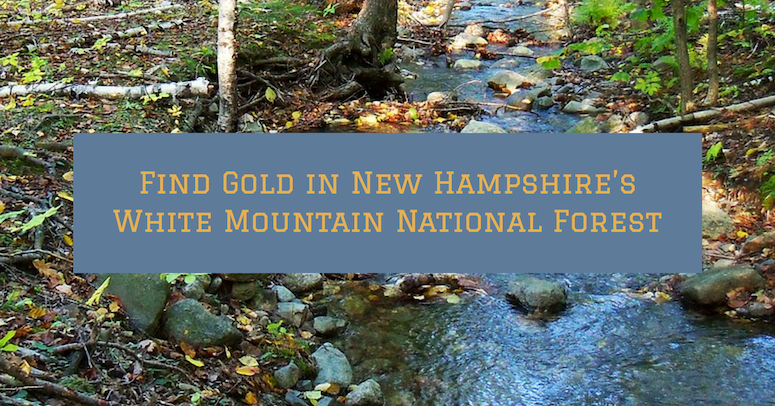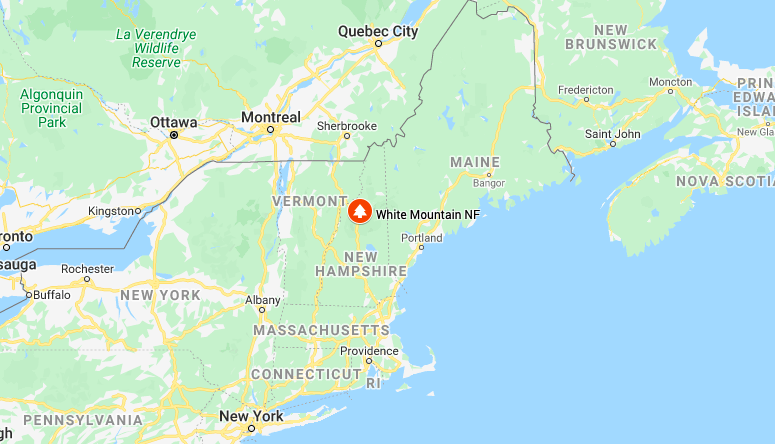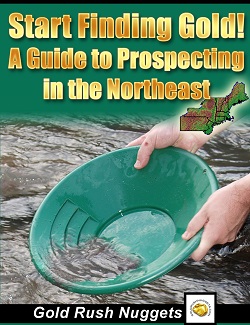
For the modern-day gold prospector, one of the better areas available to look for gold in New Hampshire is in the White Mountain National Forest. It spans across 1,225 square miles, with over 600 miles of rivers and streams within the forest. Many of these waters contain gold.
These are generally limited quantities present, and it would be best to limit expectations. While there is certainly enough gold to keep any dedicated prospector excited, you aren’t going to retire on the gold you find here.
Gold prospecting in the White Mountain National Forest is still a very popular activity and a wonderful way to get out and explore the mountains.
The Shortest of Gold Rushes
There was a tiny gold rush in New Hampshire in the 1860s after a gold discovery was made just west of White Mountain National Forest near the town of Bath, NH. A few mines were established, and they did produce some decent gold for a few years. Records from the Philadelphia Mint show that around 2000 ounces of raw gold were shipped to the mint between 1864 and 1878.
Additional mines operated around Ossipee on a small-scale. Overall, gold production across the state has been insignificant. At this time in history, the gold camps were booming across the Western United States, and very few miners were giving New Hampshire any attention at all.

The Source: Gold Ride the Glaciers
While glaciers were likely responsible for a great amount of the placer gold that is found across New Hampshire, there are some known lode deposits. In fact, those early mines around Bath did extract some ores that were crushed and processed. Certainly much of the placer deposits come from veins that eroded and sourced the gold.
The story behind some of the gold deposits found in the White Mountains is that the gold you find here is not really from here. Much of the gold was actually transported south by glaciers during the past ice ages. These huge glaciers belong to Quebec through which this material got to New Hampshire from the rich goldfields in Quebec, and when the ice melted it left behind small gold deposits.
The gold from these glacially transported gold deposits that most of the time result in fine-textured gold. The large pieces of gold are ground up and reduced to a thousands tiny of pieces.
Thus, the gold you will find here won’t often be large gold nuggets. You can expect to find the deposits of fine placer gold, and you might get a nice surprise if you find a large flake or a nugget. Stories of large nuggets abound, but I have my doubts. Perhaps the old-timers found a few big ones, but nowadays you should be happy with mostly dust and “pickers.”
Wherever the gold originated, it now sits deep under the gravel beds of the miles of stream that flow throughout the forest. And much of it is still waiting to be discovered.
The Ammonoosuc River Area
The gold deposits across the White Mountain National Forest area scattered across a wide area, and decent “color” can be found in many of the waterways. Most successful miners have luck within the Pemigewasset Ranger District, which is where you’ll find the Wild Ammonoosuc River and Tunnel Brook, two of the most historic gold producing waters in the state of New Hampshire.
The Ammonoosuc River is a quite popular place among the miners and gold prospectors to explore, though the best areas are outside of the forest. The deposits of placer gold are found along the small tributaries that add into the Ammonoosuc River. Much of the gold here is likely sourced from small lode deposits.
The single most productive area for gold prospecting has been on the Wild Ammonoosuc River. Most of the richest historic mining has taken place around Bath, at the lower end of the Wild Ammonoosuc River.
When the gold was first discovered in this area there were a few mines that were operating around the town of Bath on the Main Ammonoosuc River near the mouth of the Wild Ammonoosuc, and the miners here recovered a good amount of gold from the mines.

Small bits of gold dust panned from the White Mountain National Forest.
Rules & Regs
You need to get a permit from the Forest Service before you go out. They are available at any of the district offices. It will cover the latest rule regarding gold panning and mineral collecting within the forest. Gold prospecting is allowed across nearly all of the forest, but equipment is limited to a gold pan and basic hand tools. Larger equipment like sluices and highbankers are not allowed, per the 2005 Forest Plan:
“When surface disturbing collection activities are allowed through a permit, the following are required:
a. Only hand tools are permitted. The use of power, mechanized equipment, or explosives for recreational collecting of geologic resources, including gold recovery activities, is prohibited. This includes sluice boxes, rocker boxes, and dredges.”
Tips to Find Gold
The western side of the White Mountain National Forest is where nearly all of the historic mining has taken place. You will find that you’ll have the best success if you follow in the footsteps of those early miners, and prospect in the vicinity of the same areas that they mined. They already led you to where the gold is, and they certainly didn’t find all of it.
Pan the gravel of the Wild Ammonoosuc River and Tunnel Brook, along with any of the small drainages around Benton and Wildwood. Other occurrences have been reported in Notch Brook. There is gold in many small brooks that get very little mention, but there are many of them that you can prospect too. Put in some time and you will find gold.
Look for shallow bedrock that you can use hand tools for sniping and crevicing in the cracks of the rock. Just skimming sand and gravel from the surface won’t do. The gold is heavy, and it settles deep. You’ll discover that the best gold is found deep in the cracks that are the most difficult to clean out. Those deep cracks can be frustrating to work, but that is where the gold is hiding.
You might be surprised how well you can do with just a pan and some small hand tools once you get the method down. It can be very productive in areas where regulations restrict the use of larger equipment.
Basic Prospecting Equipment to Get you Started as a Gold Prospector

